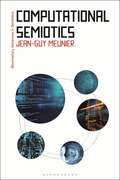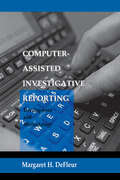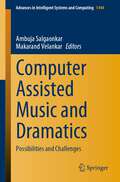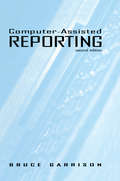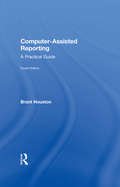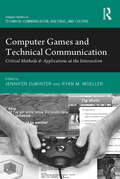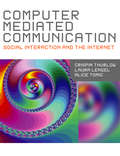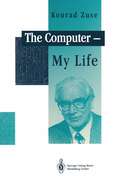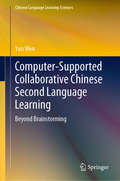- Table View
- List View
Computational Models of Reading: A Handbook (Oxford Series on Cognitive Models and Architectures)
by Erik D. ReichleThis book is about computational models of reading, or models that explain (and often simulate) the mental processes that allow us to convert the marks on a printed page into the representations that allow us to understand the contents of what we are reading. Computational Models of Reading assumes no prior knowledge of the topic and is intended for psychologists, linguists, and educators who are interested in gaining a better understanding of what happens in the mind during reading. Erik D. Reichle includes introductory chapters on reading research and computational modelling, and the "core" chapters of the book review both important empirical findings and the models designed to explain those findings within four domains of reading research: word identification, sentence processing, discourse representation, and eye-movement control (which involves coordinating word, sentence, and discourse processing with the perceptual, cognitive, and motoric systems responsible for vision, attention, and eye movements). The final chapter of the book describes a new integrative model of reading, Über-Reader, and several simulations using the models that demonstrate how it explains several key reading phenomena.
Computational Models of Reading: A Handbook (Oxford Series on Cognitive Models and Architectures)
by Erik D. ReichleThis book is about computational models of reading, or models that explain (and often simulate) the mental processes that allow us to convert the marks on a printed page into the representations that allow us to understand the contents of what we are reading. Computational Models of Reading assumes no prior knowledge of the topic and is intended for psychologists, linguists, and educators who are interested in gaining a better understanding of what happens in the mind during reading. Erik D. Reichle includes introductory chapters on reading research and computational modelling, and the "core" chapters of the book review both important empirical findings and the models designed to explain those findings within four domains of reading research: word identification, sentence processing, discourse representation, and eye-movement control (which involves coordinating word, sentence, and discourse processing with the perceptual, cognitive, and motoric systems responsible for vision, attention, and eye movements). The final chapter of the book describes a new integrative model of reading, Über-Reader, and several simulations using the models that demonstrate how it explains several key reading phenomena.
Computational Personality Analysis: Introduction, Practical Applications and Novel Directions (Springerbriefs In Complexity Ser.)
by Yair NeumanThe emergence of intelligent technologies, sophisticated natural language processing methodologies and huge textual repositories, invites a new approach for the challenge of automatically identifying personality dimensions through the analysis of textual data. This short book aims to (1) introduce the challenge of computational personality analysis, (2) present a unique approach to personality analysis and (3) illustrate this approach through case studies and worked-out examples.This book is of special relevance to psychologists, especially those interested in the new insights offered by new computational and data-intensive tools, and to computational social scientists interested in human personality and language processing.
Computational Processing of the Portuguese Language: 8th International Conference, PROPOR 2008 Aveiro, Portugal, September 8-10, 2008, Proceedings (Lecture Notes in Computer Science #5190)
by Vera Lúcia Strube De Lima Luís Caldas De Oliveira Paulo Quaresma A. Joaquim Da Silva TeixeiraThis book constitutes the thoroughly refereed proceedings of the 8th International Workshop on Computational Processing of the Portuguese Language, PROPOR 2008, held in Aveiro, Portugal, in September 2008. The 21 revised full papers and 16 revised short papers presented were carefully reviewed and selected from 63 submissions. The papers are organized in topical sections on speech analysis; ontologies, semantics and anaphora resolution; speech synthesis; machine learning applied to natural language processing; speech recognition and applications; natural language processing tools and applications; posters.
Computational Psycholinguistics: An Interdisciplinary Approach to the Study of Language (Studies in Theoretical Psycholinguistics #20)
by Matthew W. CrockerComputational Psycholinguistics: An Interdisciplinary Approach to the Study of Language investigates the architecture and mechanisms which underlie the human capacity to process language. It is the first such study to integrate modern syntactic theory, cross-linguistic psychological evidence, and modern computational techniques in constructing a model of the human sentence processing mechanism. The monograph follows the rationalist tradition, arguing the central role of modularity and universal grammar in a theory of human linguistic performance. It refines the notion of `modularity of mind', and presents a distributed model of syntactic processing which consists of modules aligned with the various informational `types' associated with modern linguistic theories. By considering psycholinguistic evidence from a range of languages, a small number of processing principles are motivated and are demonstrated to hold universally. It is also argued that the behavior of modules, and the strategies operative within them, can be derived from an overarching `Principle of Incremental Comprehension'. Audience: The book is recommended to all linguists, psycholinguists, computational linguists, and others interested in a unified and interdisciplinary study of the human language faculty.
Computational Semiotics (Bloomsbury Advances in Semiotics)
by Jean-Guy MeunierCan semiotics and computers be compatible? Can computation advance semiotics by enhancing the scientific basis of the theory of signs?Coupling semiotics, a philosophical and phenomenological tradition concerned with theories of signs, with computation, a formal discipline, may seem controversial and paradoxical. Computational Semiotics tackles these controversies head-on and attempts to bridge this gap. Showing how semiotics can build the same type of conceptual, formal, and computational models as other scientific projects, this book opens up a rich domain of inquiry toward the formal understanding of semiotic artifacts and processes. Examining how pairing semiotics with computation can bring more methodological rigor and logical consistency to the epistemic quest for the forms and functions of meaning, without compromising the important interpretive dynamics of semiotics, this book offers a new cutting-edge, model-driven theory to the field.
Computational Semiotics (Bloomsbury Advances in Semiotics)
by Jean-Guy MeunierCan semiotics and computers be compatible? Can computation advance semiotics by enhancing the scientific basis of the theory of signs?Coupling semiotics, a philosophical and phenomenological tradition concerned with theories of signs, with computation, a formal discipline, may seem controversial and paradoxical. Computational Semiotics tackles these controversies head-on and attempts to bridge this gap. Showing how semiotics can build the same type of conceptual, formal, and computational models as other scientific projects, this book opens up a rich domain of inquiry toward the formal understanding of semiotic artifacts and processes. Examining how pairing semiotics with computation can bring more methodological rigor and logical consistency to the epistemic quest for the forms and functions of meaning, without compromising the important interpretive dynamics of semiotics, this book offers a new cutting-edge, model-driven theory to the field.
Computer-assisted Investigative Reporting: Development and Methodology
by Margaret H. DeFleurConducting computer analyses for the purposes of revealing information of significance to the press represents an extension of one of the most important forms of American journalism into the contemporary era of new technologies. Investigative reporting had its start with the establishment of the metropolitan newspaper during the early decades of the 1900s. At the time, it was a continuation of the evolving tradition of freedom of the press that had characterized American political life since colonial times. As it developed, investigative reporting stressed facts rather than the opinions of the editor or reporter. In turn, that tradition had its own intellectual roots. Today, computer-assisted investigative reporting (CAIR) extends that "marketplace of ideas" into systematic examinations of the electronic records of government. In addition, computer analyses of other kinds of information systematically gathered by journalists can provide the press with insights into trends and patterns unlikely to be revealed by other means. This unique volume addresses procedures and issues in investigative journalism that have not been explained in other publications. It sets forth -- for the first time -- a detailed and specific methodology for conducting computer-assisted investigative analyses of both large and small scale electronic records of government and other agencies. That methodology consists of the logic of inquiry, strategies for reaching valid conclusions, and rules for reporting what has been revealed by the analyses to the public in clear ways. Such systematic methodologies are essential in social and other sciences and the development of a counterpart for investigative journalism has been badly needed. That systematic methodology is developed within a context that explains the origin and major characteristics of those elements that have come together in American society to make computer-assisted investigative reporting both possible and increasingly a part of standard newsroom practices. These include the development of traditional investigative journalism, the evolution of computer technology, the use of computers by government to keep records, the legal evolution of freedom of information laws, the rapid adoption of computers in newsrooms, the increasing importance of precision journalism, and the sharp increase in recent times of computer-assisted investigative reporting by American newspapers both large and small. The issues addressed in this book are discussed in a very readable context with an abundance of examples and illustrations drawn from the real world of journalism as it is practiced daily in newsrooms around the country. Explanations of concepts, principles, and procedures are set forth in layperson's terms that require very little in the way of knowledge of computers or statistical methods.
Computer-assisted Investigative Reporting: Development and Methodology
by Margaret H. DeFleurConducting computer analyses for the purposes of revealing information of significance to the press represents an extension of one of the most important forms of American journalism into the contemporary era of new technologies. Investigative reporting had its start with the establishment of the metropolitan newspaper during the early decades of the 1900s. At the time, it was a continuation of the evolving tradition of freedom of the press that had characterized American political life since colonial times. As it developed, investigative reporting stressed facts rather than the opinions of the editor or reporter. In turn, that tradition had its own intellectual roots. Today, computer-assisted investigative reporting (CAIR) extends that "marketplace of ideas" into systematic examinations of the electronic records of government. In addition, computer analyses of other kinds of information systematically gathered by journalists can provide the press with insights into trends and patterns unlikely to be revealed by other means. This unique volume addresses procedures and issues in investigative journalism that have not been explained in other publications. It sets forth -- for the first time -- a detailed and specific methodology for conducting computer-assisted investigative analyses of both large and small scale electronic records of government and other agencies. That methodology consists of the logic of inquiry, strategies for reaching valid conclusions, and rules for reporting what has been revealed by the analyses to the public in clear ways. Such systematic methodologies are essential in social and other sciences and the development of a counterpart for investigative journalism has been badly needed. That systematic methodology is developed within a context that explains the origin and major characteristics of those elements that have come together in American society to make computer-assisted investigative reporting both possible and increasingly a part of standard newsroom practices. These include the development of traditional investigative journalism, the evolution of computer technology, the use of computers by government to keep records, the legal evolution of freedom of information laws, the rapid adoption of computers in newsrooms, the increasing importance of precision journalism, and the sharp increase in recent times of computer-assisted investigative reporting by American newspapers both large and small. The issues addressed in this book are discussed in a very readable context with an abundance of examples and illustrations drawn from the real world of journalism as it is practiced daily in newsrooms around the country. Explanations of concepts, principles, and procedures are set forth in layperson's terms that require very little in the way of knowledge of computers or statistical methods.
Computer-Assisted Literary Translation (Routledge Advances in Translation and Interpreting Studies)
by Andrew Rothwell, Andy Way and Roy YoudaleThis collection surveys the state of the art of computer-assisted literary translation (CALT), making the case for its potential to enhance literary translation research and practice. The volume brings together early career and established scholars from around the world in countering prevailing notions around the challenges of effectively implementing contemporary CALT applications in literary translation practice which has traditionally followed the model of a single translator focused on a single work. The book begins by addressing key questions on the definition of literary translation, examining its sociological dimensions and individual translator perspective. Chapters explore the affordances of technological advancements and availability of new tools in such areas as post-edited machine translation (PEMT) in expanding the boundaries of what we think of when we think of literary translation, looking to examples from developments in co-translation, collaborative translation, crowd-sourced translation and fan translation. As the first book of its kind dedicated to the contribution CALT in its various forms can add to existing and future scholarship, this volume will be of interest to students and scholars in Translation Studies, especially those working in literary translation, machine translation and translation technologies.
Computer-Assisted Literary Translation (Routledge Advances in Translation and Interpreting Studies)
by Andrew Rothwell Andy Way Roy YoudaleThis collection surveys the state of the art of computer-assisted literary translation (CALT), making the case for its potential to enhance literary translation research and practice. The volume brings together early career and established scholars from around the world in countering prevailing notions around the challenges of effectively implementing contemporary CALT applications in literary translation practice which has traditionally followed the model of a single translator focused on a single work. The book begins by addressing key questions on the definition of literary translation, examining its sociological dimensions and individual translator perspective. Chapters explore the affordances of technological advancements and availability of new tools in such areas as post-edited machine translation (PEMT) in expanding the boundaries of what we think of when we think of literary translation, looking to examples from developments in co-translation, collaborative translation, crowd-sourced translation and fan translation. As the first book of its kind dedicated to the contribution CALT in its various forms can add to existing and future scholarship, this volume will be of interest to students and scholars in Translation Studies, especially those working in literary translation, machine translation and translation technologies.
Computer Assisted Music and Dramatics: Possibilities and Challenges (Advances in Intelligent Systems and Computing #1444)
by Ambuja Salgaonkar Makarand VelankarThis book is intended for researchers interested in using computational methods and tools to engage with music, dance and theatre. The chapters have evolved out of presentations and deliberations at an international workshop entitled Computer Assisted Music and Dramatics: Possibilities and Challenges organized by University of Mumbai in honour of Professor Hari Sahasrabuddhe, a renowned educator and a pioneering computational musicologist (CM) of Indian classical music. The workshop included contributions from CM as well as musicians with a special focus on South Asian arts. The case studies and reflective essays here are based on analyses of genres, practices and theoretical constructs modelled computationally. They offer a balanced and complementary perspective to help innovation in the synthesis of music by extracting information from recorded performances. This material would be of interest to scholars of the sciences and humanities and facilitate exchanges and generation of ideas.
Computer-assisted Reporting (Routledge Communication Ser.)
by Bruce GarrisonReporters in the newsroom are becoming more involved in computer-assisted reporting and online news research than ever before. This edition introduces readers to computer-assisted reporting and to describe how leading journalists are using personal computers for news gathering in modern print, broadcast, and online newsrooms. It provides a thorough discussion of technology and its applications to news reporting. Computer Assisted Reporting focuses on the computerization of newsgathering, highlighting the fact that the computer assists journalists by making writing easier, and also makes gathering and organizing information more efficient. As it begins, the book demonstrates methods for journalists to get more from their computers, such as data retrieval, data analysis, information storage, and dissemination of that information in both processed and unprocessed forms. It concludes with a refined proposal, originally proposed in the first edition, for five stages for development of computer literacy in the newsroom.
Computer-assisted Reporting
by Bruce GarrisonReporters in the newsroom are becoming more involved in computer-assisted reporting and online news research than ever before. This edition introduces readers to computer-assisted reporting and to describe how leading journalists are using personal computers for news gathering in modern print, broadcast, and online newsrooms. It provides a thorough discussion of technology and its applications to news reporting. Computer Assisted Reporting focuses on the computerization of newsgathering, highlighting the fact that the computer assists journalists by making writing easier, and also makes gathering and organizing information more efficient. As it begins, the book demonstrates methods for journalists to get more from their computers, such as data retrieval, data analysis, information storage, and dissemination of that information in both processed and unprocessed forms. It concludes with a refined proposal, originally proposed in the first edition, for five stages for development of computer literacy in the newsroom.
Computer-Assisted Reporting: A Practical Guide
by Brant HoustonThis straightforward and effective how-to guide provides the basics for any journalist or student beginning to use data for news stories. It has step-by-step instructions on how to do basic data analysis in journalism while addressing why these digital tools should be an integral part of reporting in the 21st century. The book pays particular attention to the need for accuracy in computer-assisted reporting and to both the potential and pitfalls in utilizing large datasets in journalism. An ideal core text for courses on data-driven journalism or computer-assisted reporting, Houston pushes back on current trends by helping current and future journalists become more accountable for the accuracy and relevance of the data they acquire and share. Online instructor's materials are available to adopting professors, and additional exercises are available free online to students at the below address: http://ire.org/carbook/username: carbookpassword: carbook4
Computer-Assisted Reporting: A Practical Guide
by Brant HoustonThis straightforward and effective how-to guide provides the basics for any journalist or student beginning to use data for news stories. It has step-by-step instructions on how to do basic data analysis in journalism while addressing why these digital tools should be an integral part of reporting in the 21st century. The book pays particular attention to the need for accuracy in computer-assisted reporting and to both the potential and pitfalls in utilizing large datasets in journalism. An ideal core text for courses on data-driven journalism or computer-assisted reporting, Houston pushes back on current trends by helping current and future journalists become more accountable for the accuracy and relevance of the data they acquire and share. Online instructor's materials are available to adopting professors, and additional exercises are available free online to students at the below address: http://ire.org/carbook/username: carbookpassword: carbook4
Computer-Based Diagnostics and Systematic Analysis of Knowledge
by Dirk Ifenthaler Pablo Pirnay-Dummer Norbert M. SeelWhat is knowledge? How can it be successfully assessed? How can we best use the results? As questions such as these continue to be discussed and the learning sciences continue to deal with expanding amounts of data, the challenge of applying theory to diagnostic methods takes on more complexity. Computer-Based Diagnostics and Systematic Analysis of Knowledge meets this challenge head-on as an international panel of experts reviews current and emerging assessment methodologies in the psychological and educational arenas. Emphasizing utility, effectiveness, and ease of interpretation, contributors critically discuss practical innovations and intriguing possibilities (including mental representations, automated knowledge visualization, modeling, and computer-based feedback) across fields ranging from mathematics education to medicine. These contents themselves model the steps of systematic inquiry, from theoretical construct to real-world application: Historical and theoretical foundations for the investigation of knowledge Current opportunities for understanding knowledge empirically Strategies for the aggregation and classification of knowledge Tools and methods for comparison and empirical testing Data interfaces between knowledge assessment tools Guidance in applying research results to particular fields Researchers and professionals in education psychology, instructional technology, computer science, and linguistics will find Computer-Based Diagnostics and Systematic Analysis of Knowledge a stimulating guide to a complex present and a rapidly evolving future.
Computer Games and Language Learning (Digital Education and Learning)
by M. PetersonA comprehensive and accessible overview for language educators, researchers, and students, this book examines the relationship between technological innovation and development in the field of computer-assisted language learning, exploring relevant theories and providing practical evidence about the use of computer games in language learning.
Computer Games and Technical Communication: Critical Methods and Applications at the Intersection (Routledge Studies in Technical Communication, Rhetoric, and Culture)
by Jennifer deWinter Ryan M. MoellerTaking as its point of departure the fundamental observation that games are both technical and symbolic, this collection investigates the multiple intersections between the study of computer games and the discipline of technical and professional writing. Divided into five parts, Computer Games and Technical Communication engages with questions related to workplace communities and gamic simulations; industry documentation; manuals, gameplay, and ethics; training, testing, and number crunching; and the work of games and gamifying work. In that computer games rely on a complex combination of written, verbal, visual, algorithmic, audio, and kinesthetic means to convey information, technical and professional writing scholars are uniquely poised to investigate the intersection between the technical and symbolic aspects of the computer game complex. The contributors to this volume bring to bear the analytic tools of the field to interpret the roles of communication, production, and consumption in this increasingly ubiquitous technical and symbolic medium.
Computer Games and Technical Communication: Critical Methods and Applications at the Intersection (Routledge Studies in Technical Communication, Rhetoric, and Culture)
by Jennifer deWinter Ryan M. MoellerTaking as its point of departure the fundamental observation that games are both technical and symbolic, this collection investigates the multiple intersections between the study of computer games and the discipline of technical and professional writing. Divided into five parts, Computer Games and Technical Communication engages with questions related to workplace communities and gamic simulations; industry documentation; manuals, gameplay, and ethics; training, testing, and number crunching; and the work of games and gamifying work. In that computer games rely on a complex combination of written, verbal, visual, algorithmic, audio, and kinesthetic means to convey information, technical and professional writing scholars are uniquely poised to investigate the intersection between the technical and symbolic aspects of the computer game complex. The contributors to this volume bring to bear the analytic tools of the field to interpret the roles of communication, production, and consumption in this increasingly ubiquitous technical and symbolic medium.
Computer Mediated Communication
by Crispin Thurlow Dr Lara M. Lengel Professsor Alice TomicThis book offers students a task-based introduction to Computer-Mediated Communication and the impact of the internet on social interaction. Divided into four parts which require students to learn, (theory), critique, (current issues), explore, (methods), and reflect, (practice), the book aims to: Provide a foundation to the social and communicative nature of information and communication technologies Enable students to engage with the key theoretical issues associated with CMC Equip students with the necessary research and technical skills as a stimulus to independent enquiry. In spite of the rapidly increasing interest in Internet Studies and CMC and the introduction of many university courses in the area, no specialised, introductory textbook exists. This coursebook responds to the need for such a text. Aimed primarily at communication students, this book would also be useful as a sourcebook for students of media, sociology, psychology and English Language Studies. Companion website resources can be found at http://crispinthurlow.net/cmc/
Computer Mediated Communication (PDF)
by Crispin Thurlow Dr Lara M. Lengel Professsor Alice TomicThis book offers students a task-based introduction to Computer-Mediated Communication and the impact of the internet on social interaction. Divided into four parts which require students to learn, (theory), critique, (current issues), explore, (methods), and reflect, (practice), the book aims to: Provide a foundation to the social and communicative nature of information and communication technologies Enable students to engage with the key theoretical issues associated with CMC Equip students with the necessary research and technical skills as a stimulus to independent enquiry. In spite of the rapidly increasing interest in Internet Studies and CMC and the introduction of many university courses in the area, no specialised, introductory textbook exists. This coursebook responds to the need for such a text. Aimed primarily at communication students, this book would also be useful as a sourcebook for students of media, sociology, psychology and English Language Studies. Companion website resources can be found at http://crispinthurlow. net/cmc/
Computer Processing of Oriental Languages. Language Technology for the Knowledge-based Economy: 22nd International Conference, ICCPOL 2009, Hong Kong, March 26-27, 2009. Proceedings (Lecture Notes in Computer Science #5459)
by Wenjie Li Diego Mollá-AliodThe International Conference on the Computer Processing of Oriental L- guages(ICCPOL)seriesishostedbytheChineseandOrientalLanguagesSociety (COLCS),aninternationalsocietyfoundedin1975.RecentICCPOLeventshave been held in Hong Kong (1997), Tokushima, Japan (1999), Seoul, Korea (2001), Shenyang, China (2003) and Singapore (2006). This volume presents the proceedings of the 22nd International Conference ontheComputerProcessingofOrientalLanguages(ICCPOL2009)heldinHong Kong, March 26-27, 2009. We received 63 submissions and all the papers went through a blind review process by members of the Program Committee. After careful discussion, 25 of them were selected for oral presentation and 15 for poster presentation. The accepted papers covered a variety of topics in natural language processing and its applications, including word segmentation, phrase and term extraction, chunking and parsing, semantic labelling, opinion mining, ontology construction, machine translation, information extraction, document summarization and so on. On behalf of the Program Committee, we would like to thank all authors of submitted papers for their support. We wish to extend our appreciation to the Program Committee members and additional external reviewers for their tremendous e?ort and excellent reviews. We gratefully acknowledge the Or- nizing Committee and Publication Committee members for their generous c- tribution to the success of the conference. We also thank the Asian Federation of Natural Language Processing (AFNLP), the Department of Computing, The Hong Kong Polytechnic University, Hong Kong, the Department of Systems - gineering and Engineering Management, The Chinese University of Hong Kong, Hong Kong, and the Centre for Language Technology, Macquarie University, Australia for their valuable support.
Computer-Supported Collaborative Chinese Second Language Learning: Beyond Brainstorming (Chinese Language Learning Sciences)
by Yun WenThis book explores the implementation of an online representational tool, GroupScribbles, in Chinese-as-a-second-language classrooms from primary school to secondary school. It demonstrates the effectiveness of combining online representational tools with face-to-face classroom learning, and provides a workable approach to analysing interactions interweaving social and cognitive dimensions, which take place in the networked classroom. A series of suggestions regarding networked second language learning will help educators effectively implement information and communication technology tools in the classroom.




